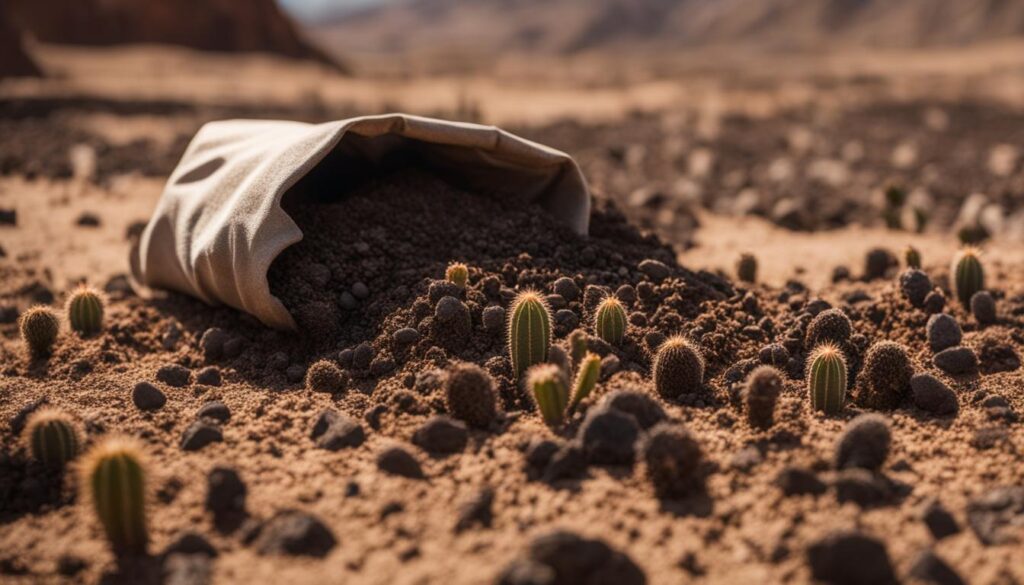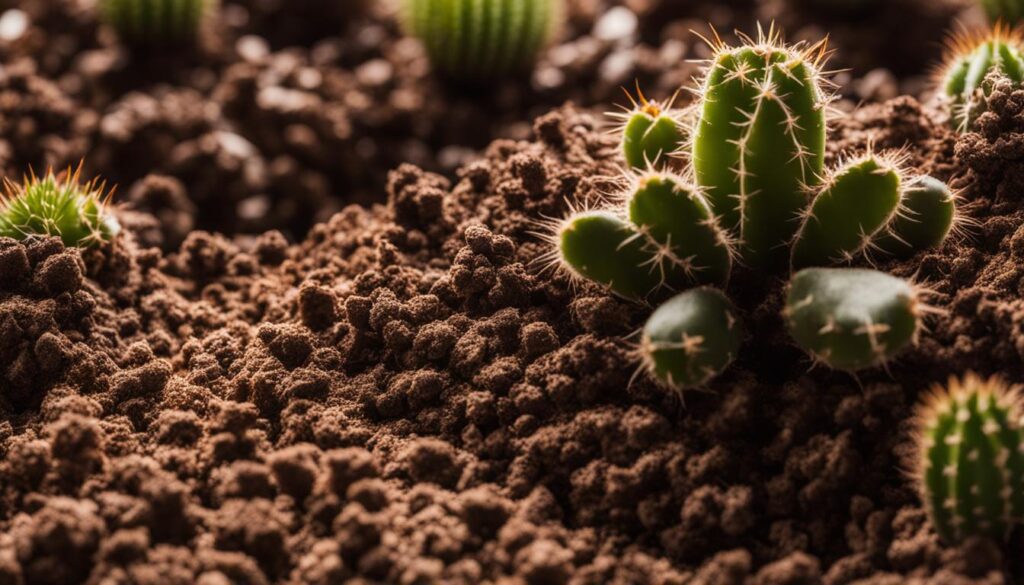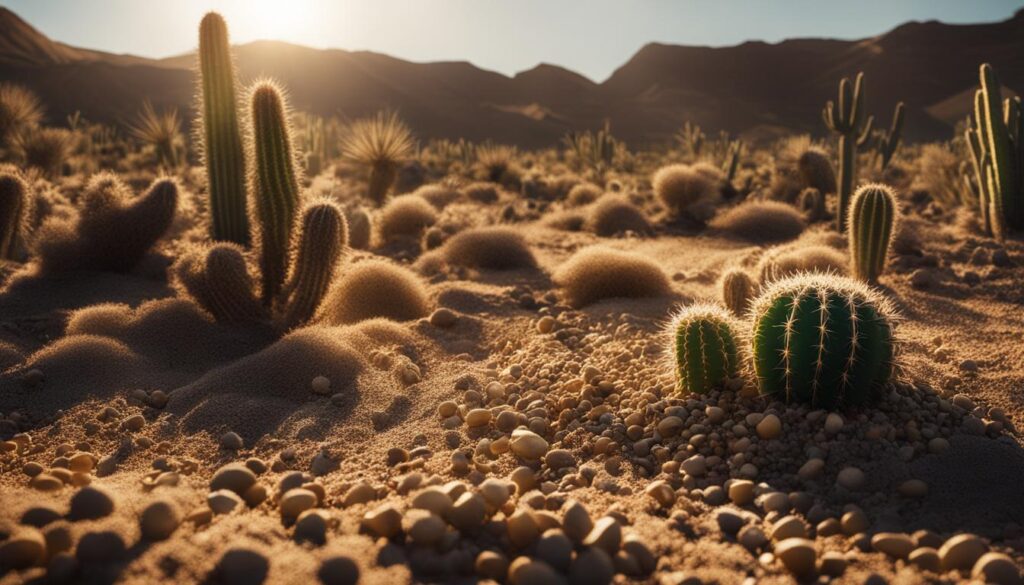When it comes to growing cacti, the right soil mix is crucial for their health and growth. Commercial cactus soils may not be suitable for all cacti species, as they often contain a combination of sand and peat that retains too much moisture. To create the ideal soil mix for cacti, a homemade blend can be made using a combination of potting soil, pumice or perlite, and coir or peat. The mix should provide good drainage, aeration, and the right level of moisture retention for cacti to thrive.
Key Takeaways:
- Creating the ideal soil mix is crucial for the health and growth of cacti.
- Commercial cactus soils may not be suitable for all cacti species.
- A homemade cactus soil mix can be made using potting soil, pumice or perlite, and coir or peat.
- The mix should provide good drainage, aeration, and the right level of moisture retention.
- Customizing the soil mix based on cacti species and personal preference is recommended.
Why Commercial Cactus Soils Might Not Work
Many gardeners turn to commercially available cactus soils for their convenience, but these mixes may not always be ideal for all cacti species. One of the main issues with commercial cactus soils is their moisture retention. These soils often contain ingredients like peat, which can retain moisture for extended periods. This can be problematic for cacti, as they require well-draining soil to prevent root rot. In humid climates, the moisture-retaining properties of commercial cactus soils can become even more problematic, leading to drainage issues and potential damage to the cacti roots.
Another drawback of commercial cactus soils is their rehydration process. Once these soils dry out, they can be difficult to re-wet due to the nature of the peat. This can result in uneven moisture distribution within the pot, which is not beneficial for the health and growth of the cacti.
While commercial cactus soils can still be used, it is important to be aware of their limitations and make necessary adjustments to improve drainage. This can include adding additional materials like pumice or perlite to enhance the soil’s drainage capabilities. By understanding the potential issues with commercial cactus soils, you can make informed decisions about the best soil mix for your cacti.
The Verdict
While commercial cactus soils offer convenience, homemade cactus soil mix provides greater flexibility and control over the soil’s composition, allowing you to tailor it to the specific needs of your cacti.
Ingredients for a Homemade Cactus Soil Mix
When it comes to creating the ideal soil mix for your cacti, using a homemade blend allows you to customize the ingredients to meet their specific needs. Here are the key components to consider:
- Potting soil: Provides a base for the mix and helps retain some moisture.
- Pumice or perlite: Improves drainage and prevents the soil from becoming waterlogged.
- Coir or peat: Helps retain moisture while providing structure to the mix.
- Optional additives: Time-release fertilizer and bone meal can be added for additional nutrients.
The proportions of each ingredient can vary depending on personal preference and the specific cactus species being grown. Experimenting with different ratios can help you find the perfect balance for your plants.
Benefits of Each Ingredient
Each ingredient in the homemade cactus soil mix serves a specific purpose. Potting soil provides the base and nutrients, while pumice or perlite ensures proper drainage and aeration. Coir or peat helps retain some moisture without causing waterlogging. The optional additives, such as time-release fertilizer and bone meal, provide additional nutrients for healthy growth.
By combining these ingredients in the right proportions, you can create a well-balanced soil mix that promotes the overall health and growth of your cacti.
| Ingredient | Role |
|---|---|
| Potting soil | Provides nutrients and a base for the mix |
| Pumice or perlite | Improves drainage and prevents waterlogging |
| Coir or peat | Retains moisture and provides structure |
| Time-release fertilizer | Provides slow-release nutrients over time |
| Bone meal | Promotes healthy growth |
Remember to adjust the proportions of each ingredient based on your cacti’s specific needs and your personal preferences. Finding the right balance will help ensure the success of your homemade cactus soil mix.
Choosing the Right Container and Measuring Device
When it comes to mixing your own homemade cactus soil, having the right container and measuring device is essential for achieving consistency in proportions and preventing spills. A suitable container should be spacious enough to hold all the ingredients without overflowing and should have a tight-fitting lid to keep the mix contained and free from moisture or pests. Plastic storage tubs or a wheelbarrow can work well for this purpose, providing ample space and easy access for mixing.
In addition to a suitable container, a measuring device is crucial for maintaining consistency in proportions. Eyeballing the amounts of each ingredient can lead to inconsistent mixes from batch to batch, affecting the overall performance of the soil mix. To ensure accuracy, consider using a plastic ice cream container or a scoop as a measuring device. This will help you precisely measure and maintain the right ratios of potting soil, pumice or perlite, coir or peat, and any additional amendments for a well-balanced homemade cactus soil mix.
By using the appropriate container and measuring device, you can create a consistent and reliable homemade cactus soil mix that provides the necessary drainage, aeration, and moisture retention for your cacti to thrive. This attention to detail will ensure that your cacti receive the proper growing environment, setting them up for success.
Table: Recommended Container and Measuring Device for Mixing Cactus Soil
| Container | Measuring Device |
|---|---|
| Plastic storage tubs | Plastic ice cream container |
| Wheelbarrow | Scoop |
Choosing the right container and measuring device for mixing your own homemade cactus soil is crucial for achieving consistency in proportions and preventing spills. A suitable container, such as a plastic storage tub or a wheelbarrow, should provide ample space and easy access for mixing the ingredients. Additionally, using a measuring device like a plastic ice cream container or a scoop will help maintain accurate proportions of each ingredient, resulting in a well-balanced soil mix for your cacti.
Organic and Inorganic Components of a Homemade Cactus Soil Mix
Creating the ideal soil mix for cacti involves a careful balance of organic and inorganic components. These components work together to provide the right soil structure and moisture retention that cacti need to thrive. The organic components, such as potting soil and coir, help retain some moisture while providing structure to the mix. On the other hand, the inorganic components, such as pumice or perlite, improve drainage and prevent waterlogging. Let’s take a closer look at each component and their role in creating a well-balanced soil mix.
The Organic Components:
Potting soil is a common organic component used in homemade cactus soil mixes. It provides some moisture retention while still allowing excess water to drain away. Coir, also known as coconut fiber, is another organic ingredient that helps retain moisture in the soil. It has excellent water-holding capacity and aids in maintaining the right level of moisture for cacti. When combined, potting soil and coir create a stable and moisture-retentive foundation for the soil mix.
The Inorganic Components:
Pumice and perlite are commonly used inorganic components in homemade cactus soil mixes. They provide excellent drainage and prevent the soil from becoming waterlogged, which is crucial for cacti as they are susceptible to root rot. Pumice is a lightweight volcanic rock that retains some moisture while allowing excess water to drain away. Perlite, on the other hand, is a lightweight volcanic glass that creates air pockets in the soil, improving aeration and drainage. When added to the mix, pumice or perlite ensures that water moves through the soil quickly, preventing the roots from sitting in wet conditions.
To achieve the right balance, a typical homemade cactus soil mix may consist of approximately 50% potting soil, 25% pumice or perlite, and 25% coir. However, the proportions can be adjusted based on personal preference and the specific needs of the cacti being grown. It’s essential to experiment with different ratios to find the perfect mix that works best for your cacti.
| Organic Components | Inorganic Components |
|---|---|
| Potting soil | Pumice or perlite |
| Coir | Pumice or perlite |
“By combining organic and inorganic components in a homemade cactus soil mix, you can create the ideal environment for your cacti to flourish. The organic components provide some moisture retention and structure, while the inorganic components ensure optimal drainage and aeration. It’s important to find the right balance between these components to mimic the natural desert habitat of cacti and promote their overall health and growth.”
Alternative Ingredients for a Homemade Cactus Soil Mix
While pumice, coir, and potting soil are commonly used in homemade cactus soil mixes, there are alternative ingredients that can be used if these are not readily available. These substitutes can help create a balanced soil mix that provides the necessary drainage and aeration for cacti to thrive. Here are some options:
- Substitutes for Pumice: If pumice is not available, perlite can be used as an alternative. Non-soluble cat litter or aquatic plant soil can also be suitable substitutes.
- Substitutes for Coir: In the absence of coir, peat can be used as a substitute. However, it is important to adjust the proportions accordingly as peat can retain more moisture than coir.
- Substitutes for Potting Soil: Instead of potting soil, a mix of pumice or grit can be used to provide the necessary drainage and aeration for cacti.
Note: When using alternative ingredients, it is important to make adjustments to the proportions and monitor the moisture levels of the soil mix to ensure the optimal growing conditions for your cacti.
By making suitable substitutions based on availability, you can still create a well-balanced homemade cactus soil mix that meets the needs of your cacti. Just remember to consider the moisture retention and drainage properties of the alternative ingredients to provide the best growing environment for your plants.
| Ingredient | Substitute Options |
|---|---|
| Pumice | Perlite, non-soluble cat litter, aquatic plant soil |
| Coir | Peat (adjust proportions for moisture retention) |
| Potting Soil | Pumice or grit |
Benefits of Adding Time-Release Fertilizer and Bone Meal
While creating the ideal soil mix is crucial for the health and growth of your cacti, adding time-release fertilizer and bone meal can offer additional benefits. Time-release fertilizer provides a slow release of nutrients over several months, reducing the need for frequent fertilization. This can help ensure that your cacti receive a steady supply of essential nutrients for optimal growth and development.
Bone meal, although its effects on cacti are not fully understood, has been used by some growers to promote healthy growth. It is thought to be a source of phosphorus and calcium, which are important for root development and overall plant health. Adding bone meal to your soil mix can potentially enhance the nutrient content and support the growth of your cacti.
Please note that the addition of time-release fertilizer and bone meal is optional and should be adjusted based on personal preference and the specific needs of your cacti. It’s always a good idea to carefully read and follow the instructions provided by the manufacturer to ensure the correct application of these supplements.
Table: Comparison of Time-Release Fertilizer and Bone Meal
| Factors | Time-Release Fertilizer | Bone Meal |
|---|---|---|
| Nutrient Release | Slow and continuous release over several months | Gradual release as it breaks down in the soil |
| Essential Nutrients | Contains a balanced mix of macro and micronutrients | Rich in phosphorus and calcium |
| Application Frequency | Less frequent application required | May require occasional reapplication as it breaks down |
| Effects on Growth | Promotes overall plant growth and development | May enhance root development and overall plant health |
“Adding time-release fertilizer and bone meal to your cactus soil mix can provide valuable nutrients for your cacti and support their overall health and growth.”
Remember to always monitor your cacti’s growth and adjust your care routine accordingly. While time-release fertilizer and bone meal can offer benefits, it’s essential to strike a balance and avoid over-fertilization, which can be detrimental to your cacti’s health. With the right care and attention to nutrient supplementation, you can help your cacti thrive and flourish.
Mixing the Ingredients for the Homemade Cactus Soil Mix
Once you have gathered all the necessary ingredients for your homemade cactus soil mix, it’s time to mix them together. This crucial step ensures that the components are evenly distributed throughout the mix, providing your cacti with the right balance of drainage, aeration, and moisture retention. To mix the ingredients, you will need a garden trowel or small shovel as tools for efficient blending.
Start by placing all the ingredients in a suitable container, such as a plastic storage tub or wheelbarrow. This container should be large enough to comfortably hold all the materials and allow for easy mixing without any spills. Having a container dedicated to this purpose will make the mixing process more organized and minimize any mess.
Using your garden trowel or small shovel, thoroughly blend the ingredients together until they are well-mixed. Take care to ensure that there are no clumps or uneven distribution of the components. By mixing the ingredients properly, you will achieve a consistent texture and appearance throughout the soil mix.
Remember, the proportions of each ingredient can be adjusted based on personal preference and the specific needs of your cacti. Experiment with different ratios to find the mix that works best for your plants. Once the ingredients are well-mixed, your homemade cactus soil is ready to be used for potting or repotting your beloved cacti.
| Tools for Mixing | Pros | Cons |
|---|---|---|
| Garden trowel | – Easy to use – Efficient for small batches |
– May not be suitable for large quantities – Requires manual effort |
| Small shovel | – Suitable for larger quantities – Faster mixing |
– May be more challenging to handle – Requires more physical strength |
Note: Find the tool that works best for you and your preferred batch size. Remember to prioritize your comfort and efficiency while mixing the ingredients.
Now that you’ve successfully mixed all the ingredients for your homemade cactus soil mix, you have created a well-balanced blend that meets the specific needs of your cacti. Whether you choose to use a homemade mix or a commercially available one, providing your cacti with the right soil is essential for their health and growth.
Commercial Cactus Soil Options for Those Who Prefer Ready-Made Mixes
While creating your own homemade cactus soil mix offers flexibility and customization, there are also commercial options available for those who prefer ready-made mixes. These commercially prepared cactus soils can be convenient and time-saving, especially for beginner gardeners or those who may not have access to all the necessary ingredients. Several trusted brands offer a range of options that provide good drainage and aeration for your cacti.
Some popular brands of commercial cactus soil include Dr. Earth, EB Stone, Bonsai Jack, and Tank’s. These products are specifically formulated to meet the needs of cacti and other succulent plants. You can find these ready-made mixes both online and at local garden centers. Before making a purchase, it is recommended to read product descriptions and customer reviews to ensure that the mix aligns with the specific requirements of your cacti.
By opting for commercially prepared cactus soil, you can save time and effort in sourcing and mixing the ingredients yourself. These ready-made mixes often provide a consistent blend of organic and inorganic components to promote healthy growth and prevent issues like overwatering. However, it is still important to consider the specific needs of your cacti species and adapt the watering schedule accordingly, as different cacti have different moisture requirements.
| Brand | Description | Price |
|---|---|---|
| Dr. Earth | A popular choice among cactus enthusiasts, this brand offers a well-balanced mix with excellent drainage and organic ingredients. | $10 |
| EB Stone | This brand focuses on sustainability and eco-friendly practices, providing a cactus soil mix that is rich in nutrients. | $12 |
| Bonsai Jack | Known for its fast-draining properties, this brand’s cactus soil mix is ideal for cacti species that are sensitive to excess moisture. | $15 |
| Tank’s | Offering a wide range of specialized soil mixes, this brand has options specifically formulated for different types of cacti and succulents. | $8 |
When choosing a ready-made cactus soil mix, consider factors such as price, availability, and the reputation of the brand. It is also a good idea to consult with experienced cactus growers or gardening communities for recommendations based on your specific needs. Whether you opt for a homemade mix or a commercially prepared one, providing your cacti with the right soil is essential for their overall health and successful growth.
Storing and Reusing Homemade Cactus Soil Mix
After creating your homemade cactus soil mix, you may have some left over for future use. Properly storing the mix is essential to maintain its quality and prevent contamination. Here are some tips on how to store and reuse your homemade cactus soil mix:
- Choose a suitable container: Select a container that is large enough to hold the remaining soil mix and has a tight-fitting lid. Plastic storage bins, covered trash cans, or pails with lids work well to keep the mix contained and protected.
- Prevent moisture and pests: Ensure that the container is clean and dry before storing the soil mix. Moisture can lead to the growth of mold or bacteria, while pests like insects or rodents can contaminate the mix. Keep the container in a cool, dry place away from direct sunlight.
- Label the container: It’s important to label the container with the date of preparation to keep track of the freshness of the mix. This will help you determine if it’s still suitable for use when you need it again.
- Check for contamination: Before reusing the stored mix, inspect it for any signs of contamination. Look for mold growth, unusual odors, or the presence of insects or pests. If any of these are present, it’s best to discard the mix and prepare a fresh batch.
By following these guidelines, you can store your homemade cactus soil mix effectively and reuse it when needed. It’s important to remember that the stored mix should retain its original texture and appearance to provide the right drainage and aeration for your cacti.
Now that you know how to store and reuse your homemade cactus soil mix, you can ensure that you always have a fresh supply on hand for potting or repotting your cacti. With proper storage, you can confidently use the mix whenever you need it, knowing that it will provide the ideal conditions for your cacti to thrive.
Table: Storing and Reusing Homemade Cactus Soil Mix Guidelines
| Guidelines | Description |
|---|---|
| Choose a suitable container | Select a container that can hold the remaining soil mix and has a tight-fitting lid. |
| Prevent moisture and pests | Ensure the container is clean, dry, and placed in a cool, dry area away from direct sunlight to avoid moisture and pest contamination. |
| Label the container | Clearly label the container with the date of preparation to keep track of the freshness of the mix. |
| Check for contamination | Inspect the stored mix for mold growth, unusual odors, or the presence of insects or pests before reusing it. |
Best Practices for Growing Cacti in Homemade or Commercial Cactus Soil Mix
When it comes to growing cacti, following proper soil mix guidelines and watering practices is essential. Whether you choose a homemade cactus soil mix or a commercially available one, there are a few best practices that will help ensure the success of your cacti.
Cacti are adapted to dry environments and prefer well-drained soil. It is important to allow the soil to dry out completely between waterings to prevent root rot and other fungal diseases. To determine when to water your cacti, simply insert your finger into the soil up to your knuckle. If it feels dry at that depth, it’s time to water. Remember, it’s better to underwater than to overwater cacti.
In terms of sunlight, most cacti thrive in bright, indirect light. Place your cacti in a location where they will receive at least six hours of sunlight per day. However, be cautious of intense, direct sunlight, as it can cause sunburn or scorch the plants.
Proper air circulation is also important for the health of your cacti. Good airflow helps prevent the growth of mold and other pathogens. Avoid placing your cacti in areas with stagnant air, such as closed terrariums.
Table: Cactus Watering Guidelines
| Cactus Type | Watering Frequency |
|---|---|
| Desert Cacti (such as Saguaro and Barrel Cactus) | Every 2-4 weeks |
| Forest Cacti (such as Christmas Cactus and Easter Cactus) | Every 1-2 weeks |
| Epiphytic Cacti (such as Orchid Cactus and Rhipsalis) | Every 1-2 weeks |
Remember, these are general guidelines, and it’s important to observe your cacti closely and adjust watering frequency based on their specific needs. With proper care and attention, your cacti will thrive in homemade or commercial cactus soil mix.
How similar are the soil requirements for cacti and succulents?
The soil requirements for cacti and succulents are quite similar. Both plants thrive in well-draining soil, so using enhance soil for succulents can help create a suitable environment. Adding materials like perlite, sand, and gravel can improve aeration and prevent waterlogging, which are essential for healthy cacti and succulents.
Conclusion
In conclusion, creating the ideal soil for cacti is essential for their health and growth. Whether you choose to make a homemade cactus soil mix or opt for a commercially available one, the key is to ensure good drainage, aeration, and the right level of moisture retention. It is important to consider the specific needs of your cacti and select the appropriate ingredients and proportions accordingly.
Both organic and inorganic components play a crucial role in creating a well-balanced soil mix that mimics the natural desert habitat of cacti. The organic components, such as potting soil and coir, provide structure and help retain some moisture. The inorganic components, like pumice or perlite, improve drainage and prevent waterlogging.
By following the guidelines and best practices for growing cacti in cactus soil mix, such as allowing the soil to dry out between waterings and providing ample light and airflow, you can ensure the success of your cacti and enjoy their unique beauty in your home or garden. With the right soil mix, your cacti will thrive and bring joy for years to come.














